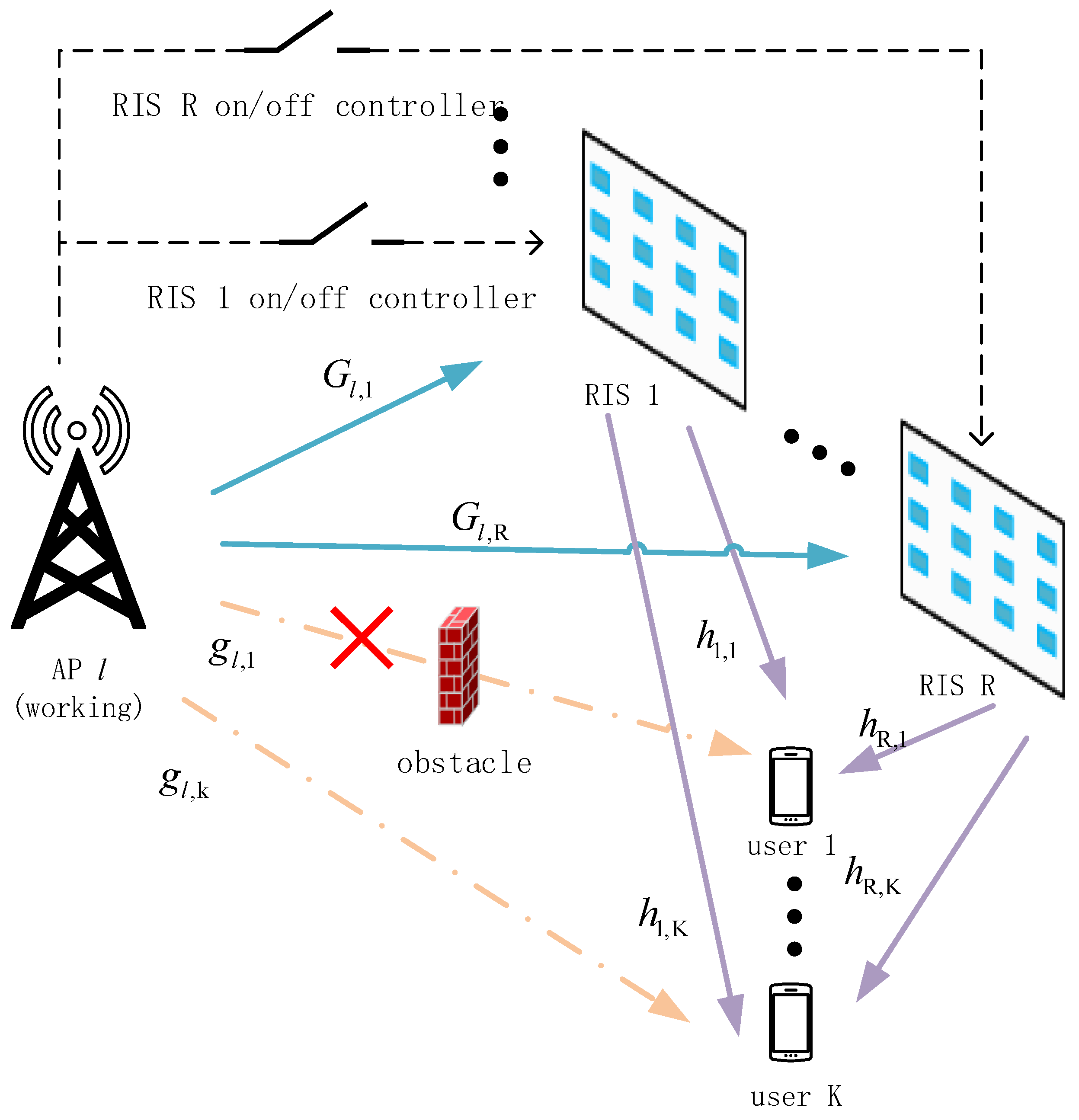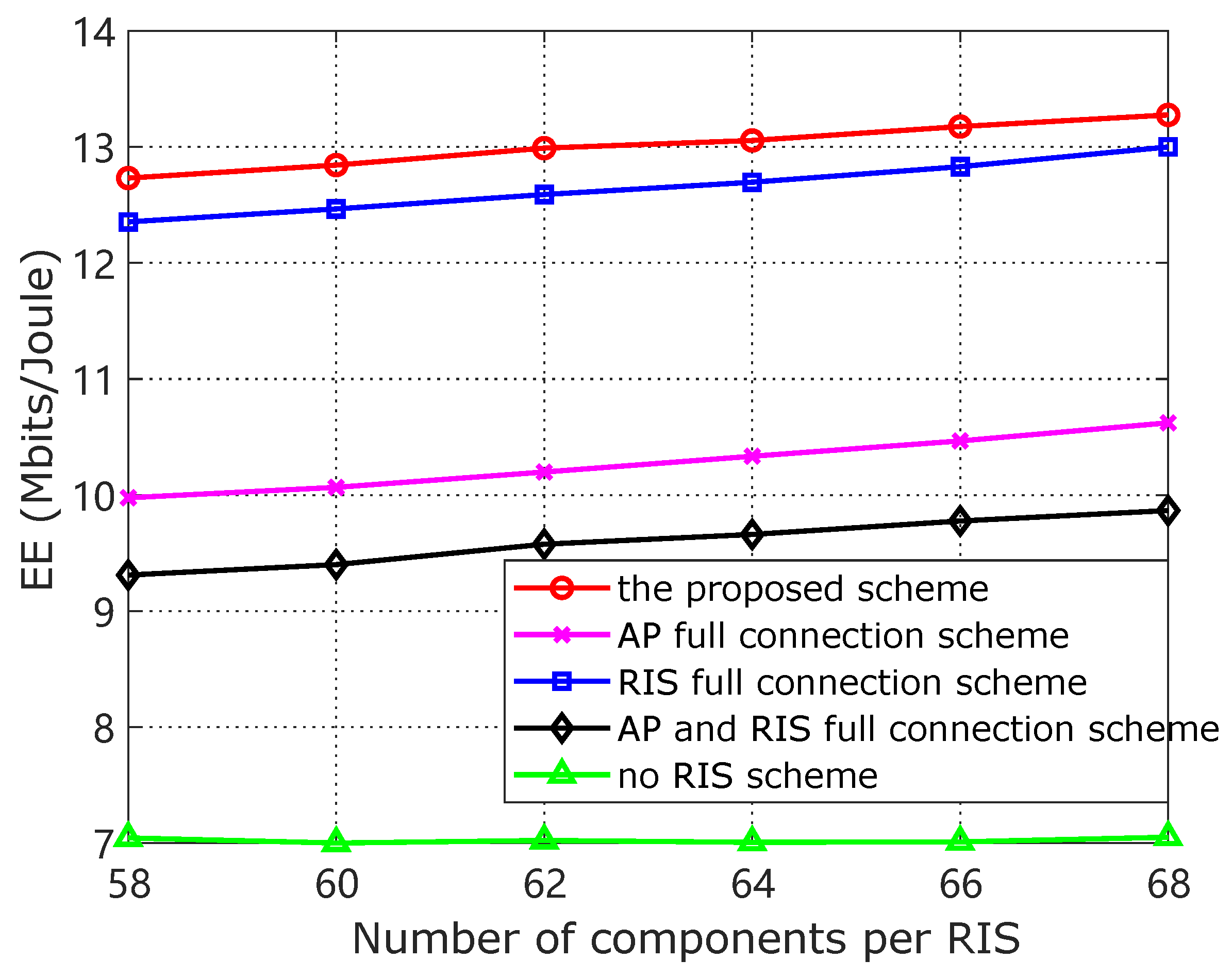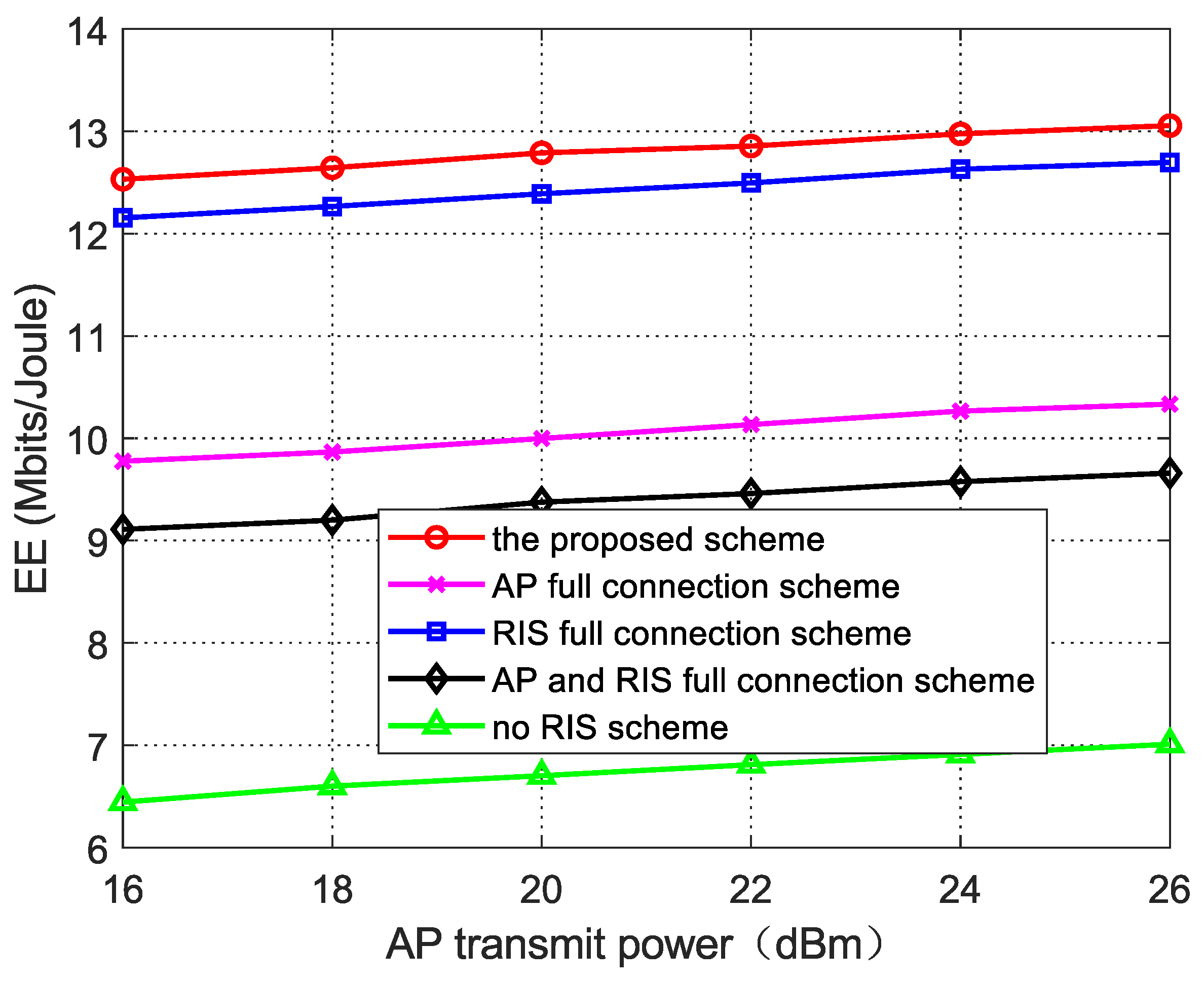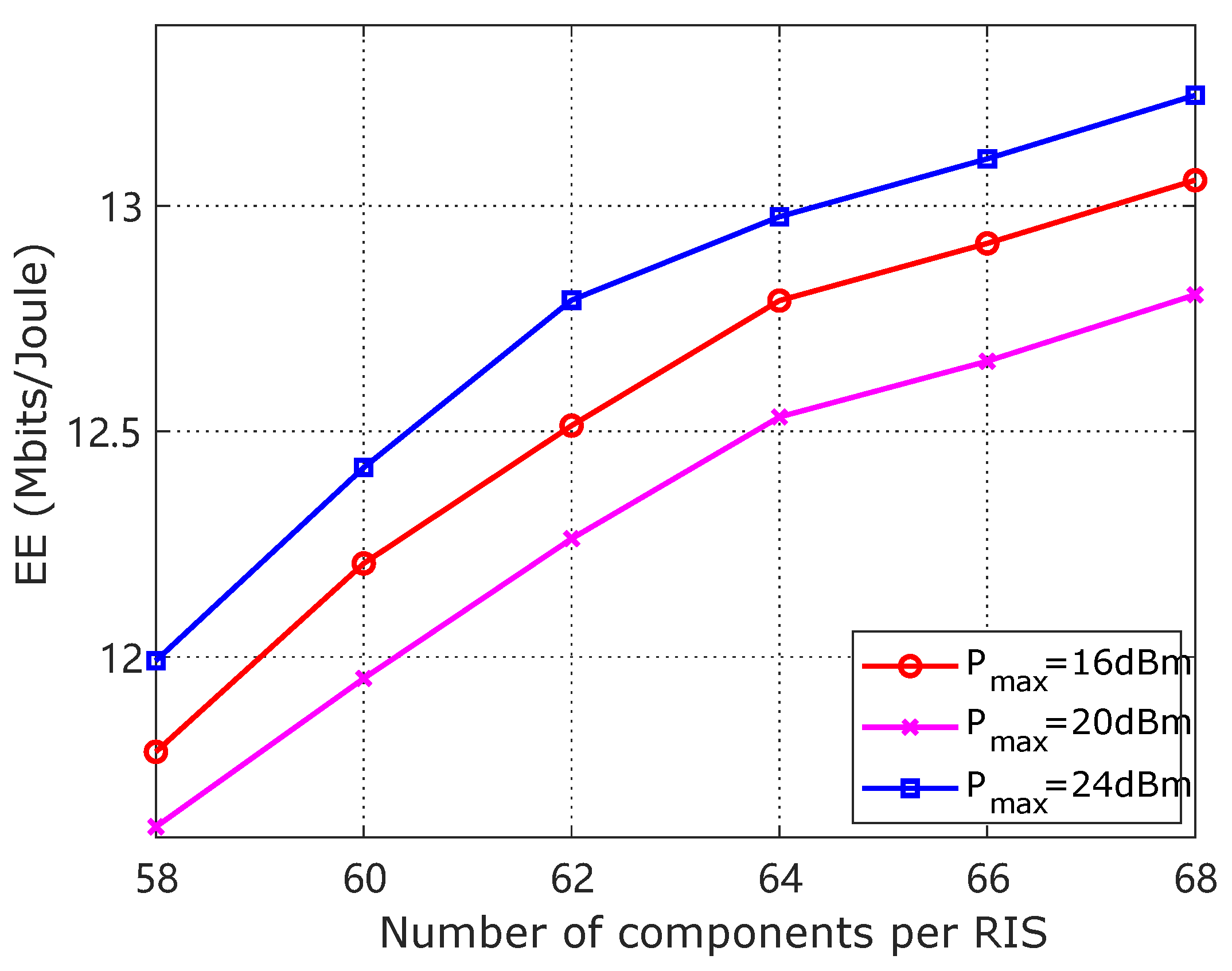Energy-Efficient Access Point Selection Scheme for Reconfigurable-Intelligent-Surface-Assisted Cell-Free Massive MIMO Systems
Abstract
1. Introduction
- An RIS-assisted CF massive MIMO system is considered, and an RIS switching strategy and an AP sleep strategy are introduced to reduce the system’s energy consumption.
- A complex optimization problem involving four variables, namely the RIS phase shift, beamforming vector, AP, and RIS integer variables, is formulated to maximize the system’s energy efficiency.
- An alternating optimization algorithm based on block gradient descent is proposed. The nonconvex optimization problem is initially decomposed into three sub-problems. In the optimization problem for RIS phase shifts, Lagrangian duality and the fractional programming method are sequentially applied, and the successive convex approximation (SCA) algorithm is utilized for problem resolution. For the beamforming vector and AP integer variable optimization problem, the variational programming method is employed to handle the integer variables, and the Dinkelbach algorithm and alternating direction method of multipliers (ADMM) algorithm are jointly utilized for problem resolution. The greedy algorithm is employed in the optimization problem for RIS switching. Finally, the optimization problem is converged through successive iterations of solving sub-problems.
2. System Model
2.1. Scenario Description
2.2. Transmission Model
2.3. Power Consumption Model
3. Problem Modeling and Solving
3.1. Problem Modeling
3.2. Problem Solving
3.2.1. Optimization of RIS Components
3.2.2. Optimization of Beamforming Vectors and AP Integer Variables
- Update the remaining variables except the Lagrange multiplier.The objective function is updated as follows:such thatThe problem can be solved directly by the cvx solver in MATLAB.
- Update the Lagrange multiplier.Lagrange multipliers are obtained by a subgradient search:
- Update the Dinkelbach auxiliary variable.Update Equation (38) until convergence.
| Algorithm 1 Joint Algorithm for Beam Coordination and AP Sleep Based on Dinkelbach and ADMM |
|
3.2.3. Optimization of the RIS Switch Variable
3.2.4. Complexity Analysis
| Algorithm 2 Alternating optimization algorithm based on block gradient descent |
|
4. Simulation Results and Analysis
5. Conclusions and Outlook
Author Contributions
Funding
Data Availability Statement
Conflicts of Interest
References
- Chettri, L.; Bera, R. A comprehensive survey on Internet of Things (IoT) toward 5G wireless systems. IEEE Internet Things J. 2019, 7, 16–32. [Google Scholar] [CrossRef]
- Hande, P.; Tinnakornsrisuphap, P.; Damnjanovic, J.; Xu, H.; Mondet, M.; Lee, H.Y.; Sakhnini, I. Extended Reality over 5G–Standards Evolution. IEEE J. Sel. Areas Commun. 2023, 41, 1757–1771. [Google Scholar] [CrossRef]
- Hong, I.P. Reviews Based on the Reconfigurable Intelligent Surface Technical Issues. Electronics 2023, 12, 4489. [Google Scholar] [CrossRef]
- Zhao, D.; Wang, G.; Wang, J.; Zhou, Z. Reconfigurable Intelligent Surface-Assisted Millimeter Wave Networks: Cell Association and Coverage Analysis. Electronics 2023, 12, 4270. [Google Scholar] [CrossRef]
- Ni, L.; Zhu, Y.; Guo, W. Controllable Multiple Active Reconfigurable Intelligent Surfaces Assisted Anti-Jamming Communication. Electronics 2023, 12, 3933. [Google Scholar] [CrossRef]
- De Figueiredo, F.A.P. An Overview of Massive MIMO for 5G and 6G. IEEE Lat. Am. Trans. 2022, 20, 931–940. [Google Scholar] [CrossRef]
- Qian, P.; Zhang, Y.; Yan, X.; Chen, Y.; Sun, Y. A Robust Scheme for RIS-Assisted UAV Secure Communication in IoT. Electronics 2023, 12, 2507. [Google Scholar] [CrossRef]
- Albreem, M.A.; Al Habbash, A.H.; Abu-Hudrouss, A.M.; Ikki, S.S. Overview of precoding techniques for massive MIMO. IEEE Access 2021, 9, 60764–60801. [Google Scholar] [CrossRef]
- Zhang, J.; Björnson, E.; Matthaiou, M.; Ng, D.W.K.; Yang, H.; Love, D.J. Prospective multiple antenna technologies for beyond 5G. IEEE J. Sel. Areas Commun. 2020, 38, 1637–1660. [Google Scholar] [CrossRef]
- Ngo, H.Q.; Ashikhmin, A.; Yang, H.; Larsson, E.G.; Marzetta, T.L. Cell-free massive MIMO versus small cells. IEEE Trans. Wirel. Commun. 2017, 16, 1834–1850. [Google Scholar] [CrossRef]
- Mai, T.C.; Ngo, H.Q.; Duong, T.Q. Downlink spectral efficiency of cell-free massive MIMO systems with multi-antenna users. IEEE Trans. Commun. 2020, 68, 4803–4815. [Google Scholar] [CrossRef]
- Galougah, S.S.; Masoumi, H.; Emadi, M.J. User management in cell-free massive MIMO systems with limited fronthaul capacity. In Proceedings of the 2021 29th Iranian Conference on Electrical Engineering (ICEE), Tehran, Iran, 18–20 May 2021; IEEE: Piscataway, NJ, USA, 2021; pp. 853–858. [Google Scholar]
- Shakya, I.L.; Ali, F.H. Joint access point selection and interference cancellation for cell-free massive MIMO. IEEE Commun. Lett. 2020, 25, 1313–1317. [Google Scholar] [CrossRef]
- Wang, J.; Wang, B.; Fang, J.; Li, H. Millimeter wave cell-free massive MIMO systems: Joint beamforming and AP-user association. IEEE Wirel. Commun. Lett. 2021, 11, 298–302. [Google Scholar] [CrossRef]
- Wu, Q.; Zhang, R. Towards smart and reconfigurable environment: Intelligent reflecting surface aided wireless network. IEEE Commun. Mag. 2019, 58, 106–112. [Google Scholar] [CrossRef]
- Zeng, S.; Zhang, H.; Di, B.; Han, Z.; Song, L. Reconfigurable intelligent surface (RIS) assisted wireless coverage extension: RIS orientation and location optimization. IEEE Commun. Lett. 2020, 25, 269–273. [Google Scholar] [CrossRef]
- Zhang, Y.; Di, B.; Zhang, H.; Lin, J.; Xu, C.; Zhang, D.; Li, Y.; Song, L. Beyond cell-free MIMO: Energy efficient reconfigurable intelligent surface aided cell-free MIMO communications. IEEE Trans. Cogn. Commun. Netw. 2021, 7, 412–426. [Google Scholar] [CrossRef]
- Alonzo, M.; Buzzi, S.; Zappone, A.; D’Elia, C. Energy-efficient power control in cell-free and user-centric massive MIMO at millimeter wave. IEEE Trans. Green Commun. Netw. 2019, 3, 651–663. [Google Scholar] [CrossRef]
- Lan, M.; Hei, Y.; Huo, M.; Li, H.; Li, W. A New Framework of RIS-Aided User-Centric Cell-Free Massive MIMO System for IoT Networks. IEEE Internet Things J. 2023, 11, 1110–1121. [Google Scholar] [CrossRef]
- Sharma, V.; Allu, R.; Singh, S.K.; Singh, K.; Duong, T.Q.; Tsiftsis, T.A. Robust Transmission Design in Multi-Objective RIS-Aided SWIPT IoT Communications. IEEE Internet Things J. 2024. [Google Scholar] [CrossRef]
- Shen, C.; Chang, T.H.; Wang, K.Y.; Qiu, Z.; Chi, C.Y. Distributed robust multicell coordinated beamforming with imperfect CSI: An ADMM approach. IEEE Trans. Signal Process. 2012, 60, 2988–3003. [Google Scholar] [CrossRef]
- Shen, K.; Yu, W. Fractional programming for communication systems—Part I: Power control and beamforming. IEEE Trans. Signal Process. 2018, 66, 2616–2630. [Google Scholar] [CrossRef]
- Dinkelbach, W. On nonlinear fractional programming. Manag. Sci. 1967, 13, 492–498. [Google Scholar] [CrossRef]
- Ben-Tal, A.; Nemirovski, A. Lectures on Modern Convex Optimization: Analysis, Algorithms, and Engineering Applications; SIAM: Philadelphia, PA, USA, 2001. [Google Scholar]
- Chen, Q.; Yang, K.; Jiang, H.; Qiu, M. Joint beamforming coordination and user selection for CoMP-enabled NR-U networks. IEEE Internet Things J. 2021, 9, 14530–14541. [Google Scholar] [CrossRef]
- Yang, Z.; Chen, M.; Saad, W.; Xu, W.; Shikh-Bahaei, M.; Poor, H.V.; Cui, S. Energy-efficient wireless communications with distributed reconfigurable intelligent surfaces. IEEE Trans. Wirel. Commun. 2021, 21, 665–679. [Google Scholar] [CrossRef]






| Parameter | Value |
|---|---|
| AP circuit power | 30 dBm |
| Maximum transmission power of AP | 26 dBm |
| User circuit power | 10 dBm |
| RIS circuit Power | 10 dBm |
| Total bandwidth | 20 MHz |
| Center frequency | 2.4 GHz |
| Noise power spectral density | −174 dBm/Hz |
| Number of AP antennas | 4 |
| The number of reflective elements of the RISs | 64 |
Disclaimer/Publisher’s Note: The statements, opinions and data contained in all publications are solely those of the individual author(s) and contributor(s) and not of MDPI and/or the editor(s). MDPI and/or the editor(s) disclaim responsibility for any injury to people or property resulting from any ideas, methods, instructions or products referred to in the content. |
© 2024 by the authors. Licensee MDPI, Basel, Switzerland. This article is an open access article distributed under the terms and conditions of the Creative Commons Attribution (CC BY) license (https://creativecommons.org/licenses/by/4.0/).
Share and Cite
Wang, W.; Song, J.; Zhou, J. Energy-Efficient Access Point Selection Scheme for Reconfigurable-Intelligent-Surface-Assisted Cell-Free Massive MIMO Systems. Electronics 2024, 13, 1397. https://doi.org/10.3390/electronics13071397
Wang W, Song J, Zhou J. Energy-Efficient Access Point Selection Scheme for Reconfigurable-Intelligent-Surface-Assisted Cell-Free Massive MIMO Systems. Electronics. 2024; 13(7):1397. https://doi.org/10.3390/electronics13071397
Chicago/Turabian StyleWang, Weiran, Jiaqi Song, and Jianguo Zhou. 2024. "Energy-Efficient Access Point Selection Scheme for Reconfigurable-Intelligent-Surface-Assisted Cell-Free Massive MIMO Systems" Electronics 13, no. 7: 1397. https://doi.org/10.3390/electronics13071397
APA StyleWang, W., Song, J., & Zhou, J. (2024). Energy-Efficient Access Point Selection Scheme for Reconfigurable-Intelligent-Surface-Assisted Cell-Free Massive MIMO Systems. Electronics, 13(7), 1397. https://doi.org/10.3390/electronics13071397






